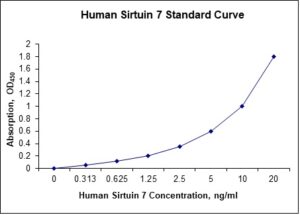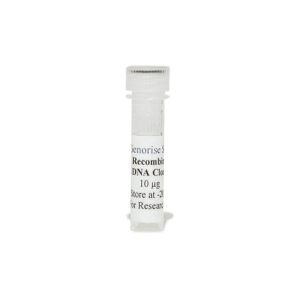Nori Human Sirtuin 7 ELISA Kit
$461.00 – $832.00
This ELISA kit is for quantification of sirtuin 7 in human. This is a quick ELISA assay that reduces time to 50% compared to the conventional method, and the entire assay only takes 3 hours. This assay employs the quantitative sandwich enzyme immunoassay technique and uses biotin-streptavidin chemistry to improve the performance of the assays. An antibody specific for sirtuin 7 has been pre-coated onto a microplate. Standards and samples are pipetted into the wells and any sirtuin 7 present is bound by the immobilized antibody. After washing away any unbound substances, a detection antibody specific for sirtuin 7 is added to the wells. Following wash to remove any unbound antibody reagent, a detection reagent is added. After intensive wash a substrate solution is added to the wells and color develops in proportion to the amount of sirtuin 7 bound in the initial step. The color development is stopped, and the intensity of the color is measured.
Alternative names for Sirtuin 7: SIRT7, SIR2L7
This product is for laboratory research use only not for diagnostic and therapeutic purposes or any other purposes.
- Description
- How Elisa Works
- Product Citations
- Reviews (0)
Description
Nori Human Sirtuin 7 ELISA Kit Summary
Alternative names for Sirtuin 7: SIRT7, SIR2L7
| Assay Type | Solid Phase Sandwich ELISA |
| Format | 96-well Microplate or 96-Well Strip Microplate |
| Method of Detection | Colorimetric |
| Number of Targets Detected | 1 |
| Target Antigen Accession Number | Q9NRC8 |
| Assay Length | 3 hours |
| Quantitative/Semiquantitative | Quantitative |
| Sample Type | Plasma, Serum, Cell Culture, Urine, Cell/Tissue Lysates, Synovial Fluid, BAL, |
| Recommended Sample Dilution (Plasma/Serum) | No dilution for sample <ULOQ; sufficient dilution for samples >ULOQ |
| Sensitivity | 62 pg/mL |
| Detection Range | 0.313-20 ng/mL |
| Specificity | Human Sirtuin 7 |
| Cross-Reactivity | < 0.5% cross-reactivity observed with available related molecules, < 50% cross-species reactivity observed with species tested. |
| Interference | No significant interference observed with available related molecules |
| Storage/Stability | 4 ºC for up to 6 months |
| Usage | For Laboratory Research Use Only. Not for diagnostic or therapeutic use. |
| Additional Notes | The kit allows for use in multiple experiments. |
Standard Curve
Kit Components
1. Pre-coated 96-well Microplate
2. Biotinylated Detection Antibody
3. Streptavidin-HRP Conjugate
4. Lyophilized Standards
5. TMB One-Step Substrate
6. Stop Solution
7. 20 x PBS
8. Assay Buffer
Other Materials Required but not Provided:
1. Microplate Reader capable of measuring absorption at 450 nm
2. Log-log graph paper or computer and software for ELISA data analysis
3. Precision pipettes (1-1000 µl)
4. Multi-channel pipettes (300 µl)
5. Distilled or deionized water
Protocol Outline
1. Prepare all reagents, samples and standards as instructed in the datasheet.
2. Add 100 µl of Standard or samples to each well and incubate 1 h at RT.
3. Add 100 µl of Working Detection Antibody to each well and incubate 1 h at RT.
4. Add 100 µl of Working Streptavidin-HRP to each well and incubate 20 min at RT.
5. Add 100 µl of Substrate to each well and incubate 5-30 min at RT.
6. Add 50 µl of Stop Solution to each well and read at 450 nm immediately.
Background:
Sirtuin 7 (SIRT7) is a NAD-dependent deacetylase that is encoded by the SIRT7 gene[1][2] SIRT7 is member of the mammalian sirtuin family of proteins, which are homologs to the yeast Sir2 protein.
SIRT7 facilitates the transcription of DNA by DNA polymerase I, DNA polymerase II, and DNA polymerase III.[3] In humans cells, SIRT7 has only been shown to interact with two other molecules: RNA polymerase I (RNA Pol I) and upstream binding factor (UBF).[2] SIRT7 is localized to the nucleolus and interacts with RNA Pol I and UBF.[4] SIRT7 is expressed more in metabolically active tissues, such as liver and spleen, and less in non-proliferating tissues, such as heart and brain.[2] Furthermore, it has been shown that SIRT7 is necessary for rDNA transcription. Knock down of SIRT7 in HEK293 cells resulted in decreased rRNA levels and the amount of RNA Pol I associated with rDNA. SIRT7 may play a crucial role in connecting the function of chromatin remodeling complexes to RNA Pol I machinery during transcription.[5] SIRT7 may help attenuate DNA damage and thereby promoting cellular survival under conditions of genomic stress.[6] Ribosomal DNA (rDNA) is more vulnerable to DNA damage than DNA elsewhere in the genome such than rDNA instability can lead to cellular senescence, and thus to senescence-associated secretory phenotype.[7] SIRT7 localizes to rDNA thereby protecting against rDNA instability and cellular senescence.[7]
References
- Frye RA (2000). Biochem Biophys Res Communications. 273 (2): 793–98.
- Ford E, et al. (2006). Genes & Development. 20 (9): 1075–80.
- Blank MF, Grummt I (2017). Transcription. 8 (2): 67–74.
- Grob A, et al. (2009). Journal of Cell Science. 122 (Pt 4): 489–98. doi:1242/jcs.042382.
- Tsai YC, et al. (2012). Molecular & Cellular Proteomics. 11 (2): M111.015156.
- Mohrin M, et al. (2015). Science. 347 (6228): 1374–77.
- Paredes S, et al. (2018). Journal of Biological Chemistry. 293 (28): 11242–11250.
Product Citations
Be the first to review “Nori Human Sirtuin 7 ELISA Kit”
You must be logged in to post a review.





























Reviews
There are no reviews yet.